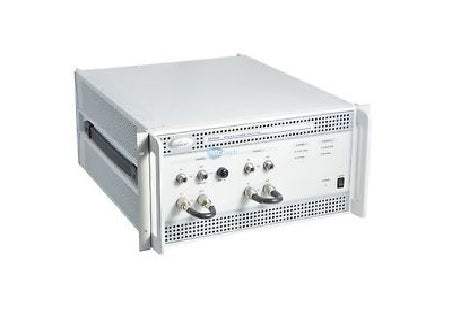

RF Input
Input Power Meter
RF Output Level
General
Dynamic Standard
Dynamic Environment Emulation
Fading Engine Type
Real-time Fading
Log-Normal Fading
AWGN (option)
Other
Applications
Benefits
The SR5500 re-creates RF fading and interference effects for testing SISO and MIMO wireless receivers. An advanced fading engine ensures accurate testing of sophisticated technologies like LTE, HSPA, HSPA+, EV-DO, WLAN and WiMAX.
The SR5500 provides extremely realistic yet repeatable emulation of RF channel conditions for testing modern wireless receivers. The emulator replicates real-world fading, spatial channel conditions, MIMO and SISO channels, Additive White Gaussian Noise (AWGN) and much more, making it possible to isolate performance issues early in the development and design verification cycle. The SR5500 is the most flexible channel emulator ever offered. It can be tailored to fit today’s requirements and budgetary business cases, yet its futureproofed modular architecture ensures that it will be ready to mee your needs in years to come.
Today’s wireless industry faces many uncertainties, including a quickly-evolving technology front. Responsible test plans require efficient, customizable integrated solutions that can address both current and future needs without incurring unnecessary risks. To accelerate time to market without forgoing accuracy, Spirent’s unique real-world emulation continues to be the first choice in test plans.
The SR5500 system can be purchased as a system solution or a fully modular solution. The only difference is that the modular version allows each SR5500 module to be run under its own GUI. While each module can be run independently in either case, the modular solution allows any module or set of modules to run under a separate GUI.
The integrated system solution
The SR5500 system solution makes use of one primary unit and one or more secondary modules. Unlike pre-racked fading “systems”, each module can be either independently controlled or used as part of a synchronized MIMO/bidirectional channel emulation solution. And unlike other monolithic faders, the SR5500 System Solution can be upgraded if you need each module to have the “brains” to interface with a separate GUI… for occasional use in separate labs, for example. Spirent’s System Solution eliminates the risk that the fading solution you choose today might be obsolete tomorrow.
Spirent SR5500 system solutions are the perfect answer when you require the best in professional fading and RF emulation today, and your test benches are co-located so they can connect to a single Ethernet interface. For owners of existing SR5500 Wireless Channel Emulators, the system solution also provides a budget-friendly upgrade to higher-order MIMO or bi-directional testing. Best of all when your needs expand, secondary modules can easily be upgraded to full stand-alone capability.
Some engineers like to personally choose the RF “plumbing” required for bi-directional testing. For those who do not, the optional RF Interface integrates all the circulators and splitters necessary for integrated bi-directional MIMO testing, and adds precise “dial-in” attenuation on a per-path basis.
The modular SR5500 solution
Sometimes you need the flexibility to test with multiple systems, each with fewer channels, but located in separate labs. The exclusive modular architecture of the SR5500 makes sure that you can concentrate fading power when you need it, but reconfigure as quickly and as often as you need to.
For example, one day you might need a completely synchronized 8x2 bi-directional MIMO environment for prototype testing in an Advanced Projects lab. The next day you might need independent 2x2 MIMO test stands in separate labs. With the SR5500’s “building block” architecture you can seamlessly move between multiple simple test stands and the more concentrated capability of a complex integrated system. No matter what configuration you deploy, you’ll have a single intuitive interface that easily makes use of all the SR5500’s unique advanced features.
Whether you choose a fully modular solution or a pre-configured static system solution, your turnkey SR5500 system will be up and running and ready to go upon delivery.
Support and Expertise
The SR5500 team includes industry experts and leaders who have dedicated many years to the study of the wireless physical layer. Our close relationships with key industry drivers and our involvement with standards organizations make certain that your SR5500 will have the feature set you need, when you need it.
Spirent’s wireless expertise extends far beyond the radio link, ensuring that channel emulation accounts for all the factors that affect real-world operation. Key areas of Spirent Physical Layer expertise include:
No matter what technology you’re working with, Spirent has qualified experts to make sure that your testing meets your intentions, and that you’ll have the features you need when you need them.
Spirent’s rich history of leadership in wireless development has established the SR5500 as the most accurate, efficient, easy-to-use solution available.
Spirent’s Channel emulation history
When a fader is used in an initial large-scale technology deployment, “getting it wrong” can make or break a business. In these cases the selection of a fading emulator includes research, rigorous evaluation and head-to-head comparative evaluations.
Spirent fading emulators were chosen for the world’s most important rollouts of new wireless technologies, including the first commercial deployments of 1x CDMA, WCDMA, FOMA, HSPA, WiMAX, and several revisions of EV-DO. They were also behind the development of the first RX Diversity device, the first Smart Antenna system, the first MIMO proof-of-concept system, and are currently used in developing LTE base stations and devices.
Spirent’s leadership in channel modeling has led to many industry firsts, including: the first emulator to integrate I/O power meters for accuracy, the first integrated AWGN, the first modular RF channel emulation system, the first dynamic correlation modeling and much more.
When your business depends on the quality of information you provide, remember that the SR5500 is always the first choice in business-critical deployments.
Model No
SR5500
Condition
Used
Manufacturer
Spirent
Hey👋Let's start with your email